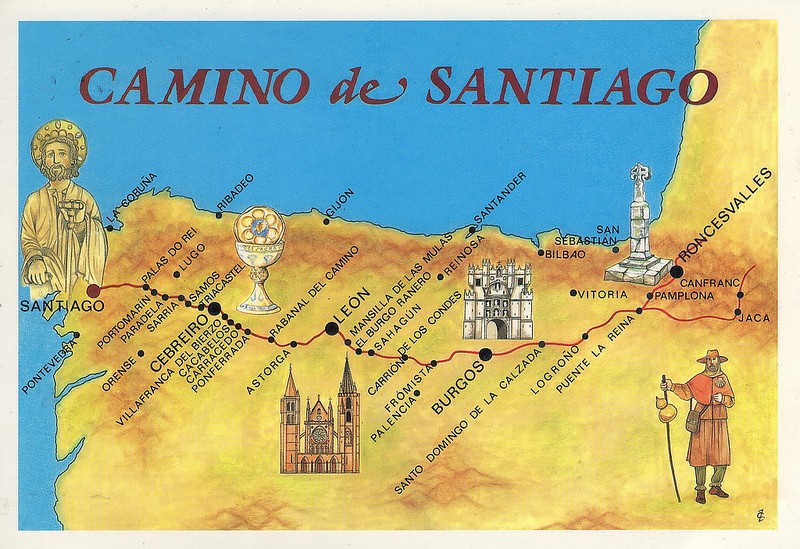In the middle of the 9th century, the Iberian peninsula was a large, bloody battlefield, as a result of the constant fighting between Christians and the Arab invaders. The south of Spain was controlled by the Arabs where they consolidated their supremacy by converting much of the old Visigoth élite to Islam. Still, Galicia, parts of Leon, Asturias, Cantabria and the Basque area have not been subdued (where the French Way passes).

Christian Spain lived under the constant threat of Muslim power and the remaining regions are very poor. As Muslim pressure grew stronger in the primitive Castilla, the area between Alava, La Rioja and La Bureba (Burgos), in the east of the kingdom, the Spanish armies needed a miracle to push the invading armies away.
It is said that political power at that time transformed one of Spain’s most beloved Christian reference, Saint James who supposedly Christianised the region after Christ’s death, to motivate their armies and get help from the Church in getting ride of Arab invaders. For this they created the myth of Santiago Matamoros and started to attract thousands of pilgrims towards the Camino de Santiago to claim Spain as the third most important Christian land and insure it would stay a Catholic land.
The Camino de Santiago in Medieval Times
The Camino de Santiago is the Christian pilgrimage to the resting place of the Apostle Saint James in Santiago de Compostela, Spain. Saint James was one of the Twelve Apostles of Jesus, and traditionally considered the first apostle to be martyred.
According to the Acts of the Apostles, James brought the new Christian message of love, hope and brotherhood to the Iberian peninsula after Jesus’ Death and was after his martyrdom brought back to Galicia to be buried.
But it was only in 813 AC, that his tomb was rediscovered and that Christians from all over Europe started making the pilgrimage to Santiago de Compostela.

The Way of St. James was one of the most important Christian pilgrimages during the Middle Ages, together with those to Rome and Jerusalem, and a pilgrimage route on which a plenary indulgence could be earned; other major pilgrimage routes include the Via Francigena to Rome and the pilgrimage to Jerusalem.
People in Medieval Times would walk the Camino for religious and spiritual reasons and also as probably the only break from a hard-working life they would ever have. The Camino was a difficult and dangerous route but also a very lucrative business for towns along the Way and a huge melting pot of nationalities and culture.
Through the Camino de Santiago, towns along the French Way and organisations like the Templars grew immensely wealthy and powerful. With Spain being regularly attacked by foreign invaders like the Vikings, the Normans and the Arabs of the Almoravids dynasty, the Camino also took a very political meaning.
The origin of the political meaning of the Camino might lie in the legendary Battle of Calvin that led to the Spanish Reconquista!
The legend of the Battle of Clavijo as it is told

In the year 844, Ramiro I of Asturias and his troops, were engaged in yet another combat with the powerful army of And al-Rahman III.
Things were not going well for the Christians, they were on the verge of defeat, when suddenly out of a cloud of dust, appeared a large, noble figure on horseback.
In his hands he held a white flag, which, when agitated by the breeze revealed a red cross.
“¡Santiago y cierra España!” (Santiago and unify Spain) cried the stranger, while he charged fearlessly towards the Arabs, waving his sword.
This warrior, who is said to be Saint James himself, terrified the Arabs, who dropped their arms and fled in panic. They slew more than 5,000 Moors, and James became known as “Matamoros”.
From that moment, the battle cry was adopted by all Christian soldiers as they fought to drive the Arabs out of Spain. It became the motivation the Spanish Army needed to stop the invasion and free their land.
The cry persisted into modern times and was frequently used as a nationalistic slogan during Franco’s long years of Fascist rule.
The true story of the Battle of Clavijo
Historians agree the battle never happened; the legends were invented centuries after the supposed event when the army’s moral was low and they needed the motivation.
Aspects of the historical Battle of Monte Laturce (859) were incorporated into this legend of the battle of Clavijo, as Claudio Sánchez-Albornoz demonstrated in 1948.
Historian Jean Mitchell-Lanham said: “While this event is based on legend, the supposed battle has provided one of the strongest ideological icons in the Spanish national identity.”
Santiago Matamoros
Saint James the Moor-slayer (Santiago Matamoros) is the name given to the representation (painting, sculpture, etc.) of the apostle Saint James the Great as this legendary, miraculous appearance at the Battle of Clavijo on 23 May 844, fighting on the Christian side against the Muslim Moors.
The Order of Santiago, a Spanish order of knighthood, originates from St. James’ supposed involvement at the Battle of Clavijo. A wide number of Mexican settlements were named Matamoros by Spanish settlers in honour of their patron saint, his cry “¡Santiago y cierra España!” (Santiago and unify Spain) was often used against the local population in Latin America.
However, ”Matamoros” is not a name nor an advocation of the saint. Today the nickname of Matamoros is politically incorrect and barely used, for fear of hurting feelings within Islam. Statues were removed from Santiago Matamoros emblematic churches like the Cathedral of Santiago de Compostela, for this reason.